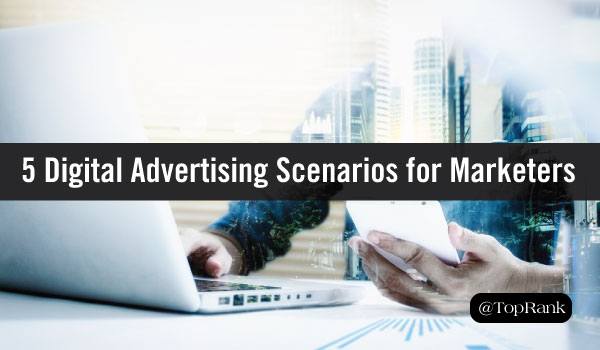
In today’s competitive and content-saturated digital landscape, it’s no secret that it’s becoming increasingly difficult to connect, engage and inspire action from our audiences using only “free” or organic marketing tactics.
As a result, digital advertising, often dubbed “pay-to-play” by marketers, is steadily on the rise. In fact, last fall, eMarketer forecasted that digital advertising spend would surpass TV ad spending for the first time in history by the end of 2016. And that trend is definitely expected to continue.
However, despite rising ad spend, consumers are actively avoiding our ads, according to a 2016 HubSpot Research report. For example, four out of five consumers reported that they closed a browser or exited a website because of an autoplaying ad or a pop up.
So what’s a marketer to do? As HubSpot so eloquently put it: “Marketers who want to connect with potential customers must supplement their target’s online experience, not interrupt it.”
To me, this means leveraging digital advertising when it makes sense and executing it in a way that enhances user experience. With that said, below I offer a handful of scenarios perfect for pay-to-play tactics, and tips for making them resonate—rather than repel—your target audience.
#1 – When you want to maximize the reach of top-performing content.
Chances are that your team has a huge portfolio of existing content—and some of those pieces are likely driving continuous traffic and engagement, and—depending on the content type—leads. As TopRank Marketing CEO Lee Odden often says: “Content isn’t King. It’s the Kingdom.” So why not get the most out of the kingdom you’ve built?
Identify high-flying pieces of content at every stage of the sales funnel, and give them a refresh if needed. Depending on where the content falls in the funnel, use your audience knowledge or customer personas to select your advertising channels and targeting options. In addition, created tailored and channel-optimized messaging for each piece you want to promote.
For example, when it comes to choosing your channels, if you want to promote an attract-level, how-to blog post, you might choose a sponsored post option on Facebook or promoted tweets on Twitter. If you’re looking to promote an engage-level white paper, you could choose to go with an account targeting campaign on LinkedIn.
Read: Working Together in Perfect Harmony: Digital Advertising + Content Marketing
Get the most out of what #content kingdom you've built with the help of #digitaladvertising. Share on X#2 – When you need to drive action under a tight deadline.
Are you hosting a webinar in the near future? Or are you hoping to drive “last-minute” registrations for an upcoming event your company is hosting? If so, digital advertising is a huge opportunity to create buzz and drive targeted traffic to your signup pages.
As always, use your audience knowledge or customer personas to help you select the right channels and targeting options, as well as craft personalized and compelling messaging. In addition, launch your campaign with multiple versions of your ads. This not only helps reduce the fatigue users could feel after seeing the same ad over and over, but gives you the opportunity to see what’s working and what’s not so you can make tweaks. After all, this is a short-term campaign, so you’ll want the ability to quickly make adjustments that will inspire action from your target audience.
#3 – When you’re fighting for search visibility in a competitive industry.
Driving search traffic is always an important objective for any marketer. But for those working in competitive industries, especially those battling well-established brands for search rankings, organic tactics may not be enough and a paid search campaign focused on top keywords may be out of budget. But, as they say, where there’s a will there’s a way, according to TopRank Marketing Digital Advertising & SEO Manager Steve Slater.
“If you have a tough road for organic SEO ahead of you, you can look at creating content around super long-tail, informational queries and bidding on them [in AdWords],” he said. “Oftentimes these queries are cheap and they can drive traffic to your site.”
Bid on super long-tail #keyword queries if you're facing a tough organic #SEO road. @TheSteve_Slater Share on X#4 – When you’ve created awesome influencer content.
From influencer research and nurturing to creating the glorious finished product, any piece of influencer content you’ve created has likely required quite a bit of work—and you absolutely want to see it reach its full potential. Digital advertising can help you maximize your reach—which can benefit your organization and the influencers you’ve worked hard to cultivate relationships with.
For example, let’s say you created an eBook featuring insights and tips from 15 industry experts. The influencers have the unique industry expertise and audience following that made them a perfect fit for the content. One way to promote your eBook, as well as take advantage of your influencers social audience, is to craft a paid Twitter campaign that specifically targets your influencers’ followers who exhibit specific behaviors such as demographics, company size or interests.
Read: Boost Your Social Media Advertising Success with These 6 Pro Tips!
#5 – When you’re a startup.
Whether you’re a niche startup or looking to break into a competitive industry, digital advertising can help jump start your digital marketing efforts—and even deliver some quick wins.
For many startups, gaining brand awareness is often a key initiative out of the gate. According to Slater, leveraging Google Display Network is a great option because of its targeting capabilities and its affordability.
“It gives you the ability to create multiple ads at scale with the ad builder tool,” he said. “You can even create responsive ads at scale—something that’s a great option for startups that don’t have the budget for a graphic designer.”
In addition, you can target the website that you want your display ads to be placed on by keyword topic. Or if you want to level up your targeting, you can use affinity audiences—or even create custom affinity audiences,” Slater added. “All this to say, the display network is a pretty affordable way to get your brand in front of your potential audience.”
Are These the Only Scenarios Fit for Digital Advertising?
Absolutely not. Digital advertising can be a staple part of your ongoing integrated digital marketing strategy. From TopRank Marketing’s perspective, the continuous work you put into building organic awareness and engagement through creating great content, thought leadership and an awesome experience is your foundation. This is how you begin to build your brand from the ground up—and that has staying power.
But adding digital advertising—whether it be paid social, paid search, remarketing or sponsored content, or a combination of paid tactics—into the mix can be the icing on the cake or a leading tactic. It just needs to make sense for your industry, audience, business objectives and budget.
In what situations have you had the most digital advertising success? Tell us in the comments section below.


